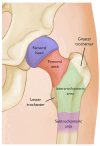Peripheral Nerve Blocks for Hip Fractures
- PMID: 38929985
- PMCID: PMC11204338
- DOI: 10.3390/jcm13123457
Peripheral Nerve Blocks for Hip Fractures
Abstract
The incidence of hip fractures has continued to increase as life expectancy increases. Hip fracture is one of the leading causes of increased morbidity and mortality in the geriatric population. Early surgical treatment (<48 h) is often recommended to reduce morbidity/mortality. In addition, adequate pain management is crucial to optimize functional recovery and early mobilization. Pain management often consists of multimodal therapy which includes non-opioids, opioids, and regional anesthesia techniques. In this review, we describe the anatomical innervation of the hip joint and summarize the commonly used peripheral nerve blocks to provide pain relief for hip fractures. We also outline literature evidence that shows each block's efficacy in providing adequate pain relief. The recent discovery of a nerve block that may provide adequate sensory blockade of the posterior capsule of the hip is also described. Finally, we report a surgeon's perspective on nerve blocks for hip fractures.
Keywords: fascia iliaca block; lateral femoral cutaneous nerve; pericapsular nerve group (PENG) block.
Conflict of interest statement
The authors declare no conflicts of interest.
Figures







References
Publication types
LinkOut - more resources
Full Text Sources

